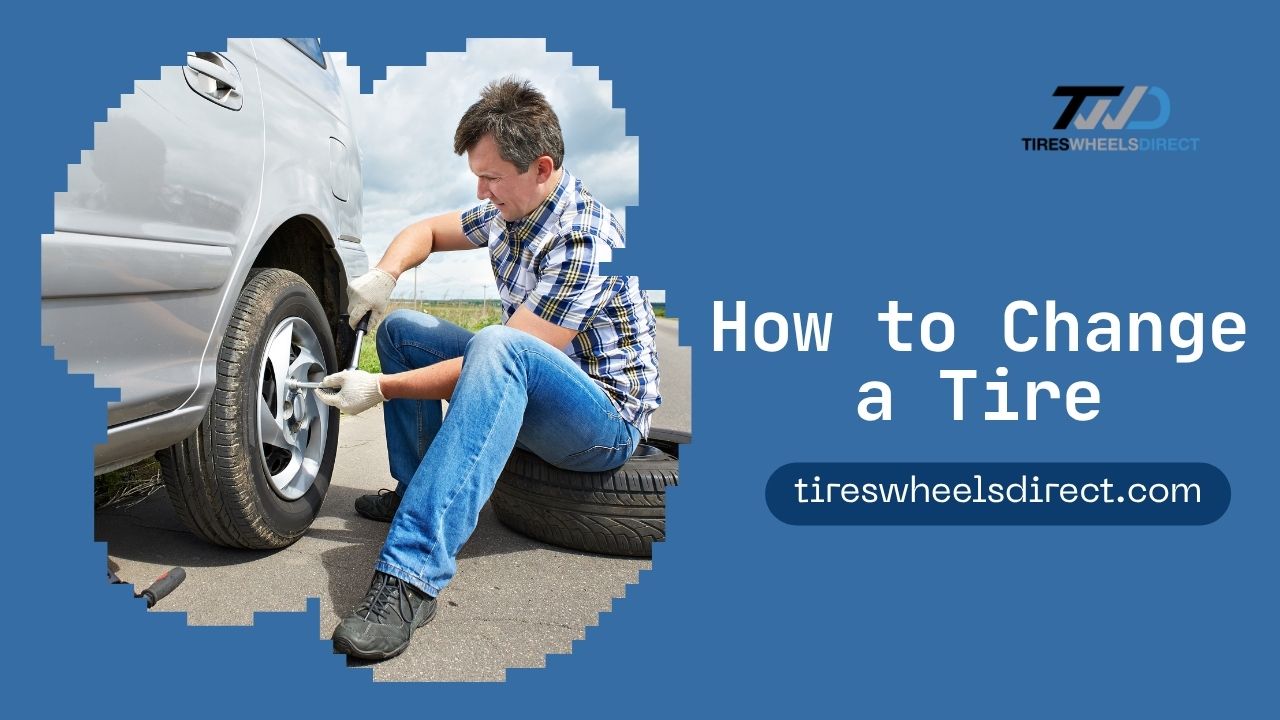How to Change a Tire In 7 Easy Steps

Have you often heard a loud pop while driving? Your car starts moving to one side. You notice it pulls to one side; when you look in the mirror, you realize you have just blown a tire. This happens to tons of drivers, literally millions of drivers every year. But don’t worry, knowing how to change a tire is a valuable skill to have.
Many people visibly shake with a flat tire, concerned about ruining their clothes, doing it wrong, and being too slow to change the flat. The good news is that changing a tire is a lot easier than many people think and most people can change a flat tire if they have the right tools and skills.
This complete guide will show everything you need to know about how to change a tire. We will break down information about vehicle and road safety, necessary tools and the steps to follow.
Table of Contents
ToggleWhy Everyone Should Know How to Change a Tire
To know how to change a tire is important for everyone because sometimes sharp objects on the road puncture your tire. Weather changes can affect tire pressure. When any of these things happen, you have to change it.
If you don't know how to change a tire, you could end up stuck in a bad place or leave you with the possibility of making you late for a scheduled appointment. Not only that, but if you need to wait for emergency services to help you, it could take hours for someone to arrive.
Many people think changing a tire is too complicated or too messy. The reality is that changing a tire is just a simple maintenance skill and not much different than checking your oil. Once you learn how to do it, you will wonder why you were ever concerned.
Essential Tools for Changing a Tire
The first thing you'll need in order to change your flat tire is to have the right tools. Most cars will come with the most basic essentials for changing a tire. So, look in your car's trunk or storage spot, you should have a spare tire, jack and either a lug wrench or a type of wrench to take your lug nuts off.
The spare tire is an important part of the toolkit. Your spare tire is the temporary replacement tire for your flat. Most spare tires are smaller than standard tires. They're designed to get you to a repair shop safely, not to speed around town. Check your spare tire pressure monthly to ensure it will be available when needed.
You will also need a jack for lifting the vehicle. The jack must lift your car high enough to remove the flat tire and replace it with a spare tire. Your car should come with a jack that was designed for the vehicle and that fits properly.
Prepare A Work Area For Your Safety
The most important part of changing a tire is security. Never try to change a tire in a dangerous place. If you are on a highway, try to get off the road. See a parking lot on a side street. Your safety is more important than anything.
Find a flat, solid surface to work on. Avoid soft ground, such as grass or gravel. These surfaces can cause your jack to drown or tip. If you should work on a slope, bend your wheels towards the curb. This prevents your car from rolling.
As soon as you stop, turn on your threat light. This alerts other drivers to the fact that you have a problem. If you have a road flare or a reflective triangle, place them behind your car. See yourself as another driver.
Steps For Changing A Tire Step By Step
1: Get Your Tools Ready
Open your trunk and get your spare tire, jack, and lug wrench. Some cars keep these tools under the floor mat. Others have them in side compartments. Check your spare tire air pressure. A flat spare tire won't help you at all. If it's low on air, you'll need to add air first.
2: Loosen the Lug Nuts
Find the lug nuts on your flat tire. These are the bolts that hold the tire to the car. Use your lug wrench to turn them counterclockwise. Please don't remove them completely yet. Loosen them just enough so that you can turn them by hand later.
The lug nuts might be very tight. You may need to use your whole body weight to turn them. Just be careful not to slip and fall. Try to use a small amount of penetrating oil if the nuts are stuck. As you loosen the lug nuts, count them. Most cars have four or five lug nuts per tire. Just be sure to loosen them all.
3: Place and Use the Jack
Look for the proper jack point on your car. This is a backed area where it's safe to lift the car. Your owner's manual will indicate where these points are located. Never put the jack under the car body or other weak parts. This could damage your car or cause it to fall.
Put the jack under the right point. Make sure it's sitting flat and stable. The jack should be perfectly vertical. If it is folded from one side, reposition it so that it is straight. A devious jack can slip, causing injury or damage.
Turn the jack handle slowly to raise the car. Go up just enough to get the flat tire off the ground. You need about six inches of clearance.
4: Remove the Flat Tire
Now you can remove the lug nuts completely. Turn them counterclockwise until they come off. Put them in a safe place where you won't lose them. A good spot is inside the hubcap or wheel cover. You'll need these same nuts for your spare tire.
Grab the tire with both hands and pull it straight toward you. Tires are heavy, so be ready for the weight. Don't try to twist or turn the tire as you remove it. This could damage the wheel bolts. If the tire seems stuck, make sure all the lug nuts are removed.
Roll the flat tire away from your work area. Don't leave it where other cars might hit it. Some people put the flat tire under the car as a safety backup. This way, if the jack fails, the tire provides some protection.
5: Install Your Spare Tire
Line your extra tires with wheel bolts. The hole in the tire should match the bolts completely. Push the tire on the wheel hub. It should sit flat against the metal surface. If it doesn't fit easily, check that you are lining it up correctly.
Change the lug nuts and tighten them by hand. Rotate them clockwise to tighten them. Do not use the wrench yet. Just pull them so that they will not fall.
Ensure that each Log nut is started properly on its thread. Cross-threading can cause permanent damage to the bolt. If a nut does not turn easily, return it and try again.
6: Lower the Car Properly
Slowly lower the jack by turning the handle to the left. Bring the car down until the spare tire only touches the ground. Do not reduce it entirely yet. You want the tire to have a little weight on it. When you tighten the nuts, it keeps it spinning.
Now use your lug wrench to tighten the nut properly. Rotate them clockwise to harass them. Use a star pattern when tightened. Tighten a nut, then cross one, then the next one. It also ensures pressure on all sides of the tire.
Make the nuts as tight as you can with a wrench. They need to be very safe. A loose tire can come loose while driving, which is extremely dangerous. Pull up on the tire to ensure this is secure.
7: Final Checks and Cleanup
Lower the car completely and remove the jack. Spare tires should now support the full weight of the car. To ensure that the tire is given a final check to ensure it is safe. To test its stability, push it at different angles. Return all your devices to their designated places. This includes a jack, lug wrench, and any other items you use. Clean your equipment if they are dirty. This helps them last longer and prepares them for next time.
Where To Buy the Best Tires For Your Car
When searching for tires for your vehicle, it is important to choose the right supplier. At Tire Wheel Direct, we offer high quality tires for every type of vehicle. We understand that good tires keep you safe on the road. Our selection includes cars, trucks, SUVs and tires for special vehicles.
At Tire Wheel Direct, we offer a wide range of popular brands at affordable prices. Our website helps you find the car you need, with the exact tire you need. You can search by the make, model and year of your vehicle.
This ensures that you get tires that fit perfectly. Further, you can calculate the overall tire diameter at Tire Wheels Direct. We want to help you make the best choice for your driving needs. Quality tires from Tire Wheel Direct give you confidence and peace of mind on every journey.
Conclusion
To conclude, everyone should know how to replace a tire. Once you have learned to change a tire, you will change a tire quickly. To prevent damage, monitor tire condition every day.
If you ever think that you cannot change a tire, try to get help from a supplier as soon as possible. You can always replace money and time but style="font-size: 20px; margin-bottom: 0px; font-weight: 600;" your safety should never be compromised.
Lastly, if you are looking for quality tires for your car, check out Tires Wheel Direct. We have a great selection of tires of all types. We even have a tire diameter calculator that will help you find the proper tire for your car.

